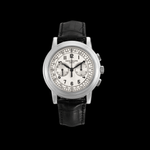Decoding the Worth: Are Luxury Watches a Lucrative Investment?

Patek Philippe
Chronograph 5070G-001
At The Second Hand Club, we are proud to offer the Patek Philippe Chronograph Ref. 5070G-001, a landmark collector’s piece that exemplifies Patek Philippe’s dedication to traditional watchmaking and mechanical excellence. Revered as the brand’s first manually wound, in-house chronograph in decades when it debuted in 1998, the 5070 has achieved legendary status—and the white gold 5070G with its elegant white dial remains one of the most refined and sought-after versions.
Crafted in 18k white gold, the 5070G-001 features a clean white dial with applied white gold numerals, a tachymeter scale, and symmetrically placed chronograph sub-dials that enhance both functionality and visual balance. Its 42mm case, with bold stepped lugs and a flat bezel, evokes the aesthetic of vintage Patek chronographs while offering modern wrist presence.
Powering the watch is the manual-winding Caliber CH 27-70, a movement based on the Lemania ébauche and extensively reworked and finished by Patek Philippe. With its column-wheel architecture, horizontal clutch, and exceptional finishing—visible through the sapphire caseback—it stands as one of the most revered chronograph movements in haute horlogerie. The 5070G-001 is not only a watch, but a symbol of Patek Philippe’s mastery of timeless chronograph design.
Our pricing model is fully transparent: We add a low 3% margin to the true cost of the watch providing buyers the most competitive price on secondary market guaranteed. However, Circle Members enjoy exclusive access to our lowest rates, with the fee reduced to just 1.5% for any watches they buy. Contact us today to secure this timepiece at the most competitive market price.
If you intend to buy more than one watch in the future, we highly recommend becoming a member. The membership will pay for itself. Become a member today.
Specifications
| Movement | Manual Winding |
|---|---|
| Calibre |
Patek Philippe In House caliber
|
| Dial | White |
| Case size | 42 mm |
| Material | White gold |
| Bracelet | Patek Philippe black alligator strap |
| Glass | Sapphire |
| Condition | Excellent |
| Box & Papers | Complete, dated papers, |
About the brand
About the watch
At The Second Hand Club, we are committed advocates for the exceptional quality of our curated selection of pre-owned timepieces and mechanical objects. In the event of an unexpected issue, we remain committed to addressing it promptly and effectively. Our client's trust and satisfaction are paramount to our entire team.
Each pre-owned watch in our collection has been meticulously examined using non-intrusive methods to confirm their mechanical integrity. Where necessary, servicing has been performed to guarantee they align with our highest standards for timekeeping precision and functional performance.
Unless explicitly indicated, our pre-owned watches are protected by either a comprehensive or a limited warranty for a period of twenty-four months. However, this warranty does not cover damages resulting from accidents or misuse. Given their vintage status, pre-owned watches may not withstand the same conditions as brand new models.
We have a no refund policy, which means that all sales are final.
In some rare cases, we will accept a return awarding you with a store credit making you eligible to choose a different watch from our inventory using your initial payment amount towards the new timepiece.
To be eligible for a return, your item must be in the same condition that you received it, unworn or unused, with tags, and in its original packaging. You’ll also need the receipt or proof of purchase.
To start a return, you can contact us at contact@thesecondhandclub.com. If your return is accepted, we’ll send you a return shipping label, as well as instructions on how and where to send your package. Items sent back to us without first requesting a return will not be accepted.
You can always contact us for any return question at contact@thesecondhandclub.com.
Damages and issues
Please inspect your order upon reception and contact us immediately if the item is defective, damaged or if you receive the wrong item, so that we can evaluate the issue and make it right.
Refunds
All sales are final. We do not issue refunds.


